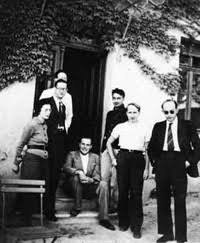
Elliptic curves are, without doubt, one of the most captivating objects in the mathematical universe. They combine two features that rarely appear together: they are simple as objects (that is, they are simple to understand… at least in a certain domain) and they are at the same time an apparently inexhaustible source of interesting problems where, in addition, multiple fields of mathematics converge, from Algebraic Number Theory to Complex Analysis, passing through Group Theory, Galois Theory, Topology or Algebraic Geometry. On top of that, the ramifications of studies on elliptic curves have in turn reached such fascinating problems as integer factorisation (thanks to the work of Lenstra, for example), cryptography (for example, the one used in Whatsapp) or, as almost everyone knows, the proof of Fermat’s Last Theorem (Wiles and Wiles/Taylor).
Today we are going to be discussing a recently solved problem (the solution has been published in arxiv on 28/07/2020) by a group of five researchers led by Maarten Derickx, from the MIT (https://arxiv.org/pdf/2007.13929.pdf). The solution is not without controversy, as it includes the refutation of a previous solution by Jian Wang of the University of Southern California, which is not surprising – remember the eventful history of the proof of Fermat’s Last Theorem – given that, with as many edges as there are in these problems, this type of situation is commonplace.

To fix ideas and to do it as simply as possible, we will say that an elliptic curve over the rational numbers is an equation of the type
$$
E: Y^2 = X^3 + AX + B,
$$
where \(A\) and \(B\) are integers. Actually the definition is more general, we can take \(A\) and \(B\) to be rational, and in fact we can consider any cubic curve without singularities and, with some algebraic machinery, we would take it to an equation of this type. A fascinating property of these curves is that they have an underlying algebraic structure. This follows from the fact that, if a line passes through two points on the curve, it necessarily passes through a third. Using this property we can define an inner operation on the set of points on the curve (denoted \(E({\mathbb Q})\)) which is written as sum (+), since it is a commutative operation.
To be precise, we should say that in fact we must consider the projective closure of \(E\). That is, adding a point at infinity, usually denoted \({\mathcal O}\) and which, in fact, is the identity element of the operation. But, in a first approximation, we can keep the idea that we can add points and also do it geometrically.
Mordell proved in the 1920s that, under these conditions, the set \(E({\mathbb Q})\) is a finitely generated abelian group and, therefore, admits a structure
$$
E({\mathbb Q})= E_T({\mathbb Q}) \oplus {\mathbf Z}^r,
$$
where \(E_T({\mathbb Q})\) is a finite set (the torsion subgroup) and therefore a product of cyclic groups, and \({\mathbf Z}^r\) is the free part. Following the traditional nomenclature of groups, \(r\) is called the rank of the curve.

Years later, Weil generalised the result to prove that, in fact, if we considered that the coefficients of the curve and the coordinates of the points belonged to any number field (that is, to a finite algebraic extension of \({\mathbb Q})\), the result was still true. Actually, Weil generalised the result in a much stronger way, including higher dimensional varieties that admit this kind of structures (abelian varieties), but we will not go into that. This theorem (now known as the Mordell-Weil Theorem) is the cornerstone of the problems we are interested in.
We know little about the rank of an elliptic curve. In fact, one of the great open problems of the domain is to prove that there exists a bound for the rank of an elliptic curve over \({\mathbb Q}\). We know that there exist curves of rank greater than or equal to \(28\), and that, statistically, elliptic curves that do not have rank \(0\) or \(1\) are rare. But we do not have closed general results, despite the large number of people working on these issues. Of course, the case of numerical fields is out of hand. Here is one of rank 20, for your amusement (Elkies/Klagsburn example):
$$
Y^2 + XY + Y = X^3 − X^2 − 244537673336319601463803487168961769270757573821859853707X + 961710182053183034546222979258806817743270682028964434238957830989898438151121499931.
$$
Concerning torsion, on the other hand, we have considerably more information. The first major result came from Mazur, in the late 1970s, who showed that, over the rationals, the torsion group has exactly 15 possibilities, to be precise:
$$
\begin{array}{rcl}
{\mathcal C}_n && n=1,2,…,10,12, \\
{\mathcal C}_2 \times {\mathcal C}_n && n=2,4,6,8,
\end{array}
$$
where we denote by \({\mathcal C}_n\) the cyclic group of \(n\) elements.
It took fifteen years before Kenku/Momose and Kamienny unveiled the equivalent result for quadratic fields (extensions of degree 2), in which case the list goes up to 26 possibilities:
$$
\begin{array}{rcl}
{\mathcal C}_n && n=1,2,…,16,18, \\
{\mathcal C}_2 \times {\mathcal C}_n && n=2,4,6,8,10,12, \\
{\mathcal C}_3 \times {\mathcal C}_n && n=3,6, \\
{\mathcal C}_4 \times {\mathcal C}_4. &&
\end{array}
$$
And it was only this summer, bringing together many partial results that began in the 1990s, that Derickx and his collaborators finally came up with the complete list for cubic fields, curiously also with 26 options:
$$
\begin{array}{rcl}
{\mathcal C}_n && n=1,2,…,16,18,20,21, \\
{\mathcal C}_2 \times {\mathcal C}_n && n=2,4,6,8,10,12,14. \\
\end{array}
$$

The difficulty of these results lies in the fact that studying possible torsion groups involves studying other objects, called modular curves (and their quotients), and specifically, knowing when these curves have points. These are generally very complicated questions of Arithmetic Geometry, which is the Mendelian cross between Number Theory and Algebraic Geometry.
Among cubic and quadratic fields, however, we must mention a really impressive result that came to light, in the mid-1990s, due to Merel. This result, called the Global Bound Theorem, states that, for any finite algebraic extension of \({\mathbb Q}\) of degree \(d\), the size of the torsion group can be bounded by a constant that depends only on \(d\). Although the bound is explicit, it is far from optimal (and in fact has been improved quite a bit since Merel published his result). This result culminated many years of collective search and had what we could call a neat ending: the proof of the conjecture that the whole community believed to be true. However, as we can see, to understand precisely and in detail what happens in the torsion subgroups of elliptic curves on number fields we still have a long way to go. But thanks to Derickx and his group, this road is one step shorter.

Leave a Reply